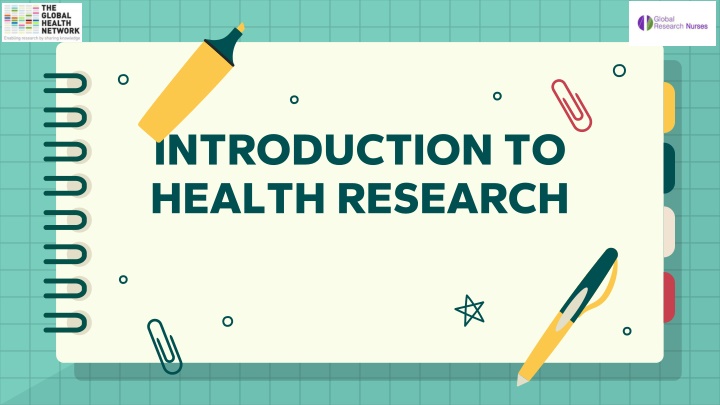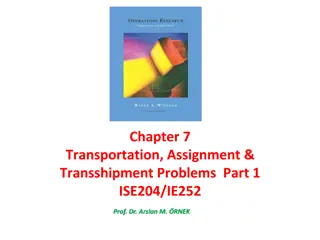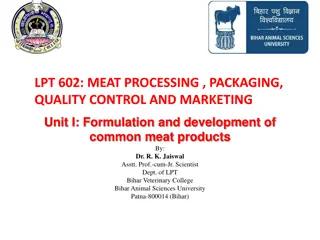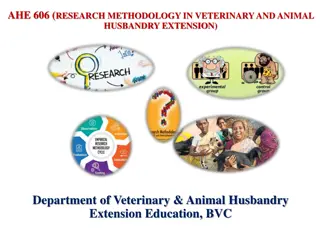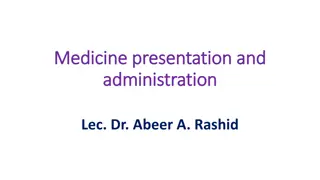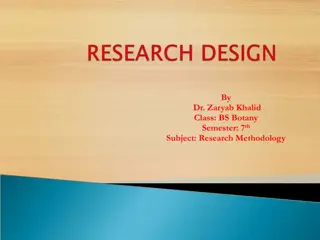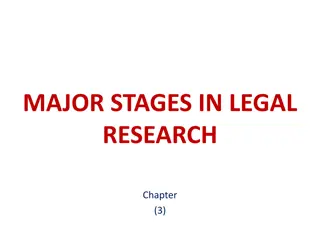Introduction to Health Research Topics Formulation and Characteristics
This presentation covers identifying research topics, formulating objectives, types of health research, and characteristics of research such as clear problem statements, systematic processes, and clear outcomes. Learn about different types of research and when to prioritize research topics based on relevance, timeliness, and ethical acceptability.
Uploaded on Mar 15, 2025 | 1 Views
Download Presentation

Please find below an Image/Link to download the presentation.
The content on the website is provided AS IS for your information and personal use only. It may not be sold, licensed, or shared on other websites without obtaining consent from the author.If you encounter any issues during the download, it is possible that the publisher has removed the file from their server.
You are allowed to download the files provided on this website for personal or commercial use, subject to the condition that they are used lawfully. All files are the property of their respective owners.
The content on the website is provided AS IS for your information and personal use only. It may not be sold, licensed, or shared on other websites without obtaining consent from the author.
E N D
Presentation Transcript
INTRODUCTION TO HEALTH RESEARCH
Presentation layout Description of Health research How to identify research topics 01 04 Formulation of research objectives and problem statement 02 05 Characteristics of Health Research Types of Health Research 03 06 Literature review
Health Systems Research A systematic collection, analysis and interpretation of health and health-related data to answer a certain question or to solve a problem
Characteristics of research 1. Demands a clear statement of the problem 2. Requires clear objectives & methods 3. Builds on existing data 4. Involves systematic process 5. Have a clear vision of the outcome
Types of Research 1. Basic research 2. Applied research 3. Quantitative research 4. Qualitative research
When does a problem situation requires research? 1. When there is a perceived discrepancy between what is available on the ground and the ideal desired scenario. 2. When reasons for the discrepancy are unclear 3. When there is more than one possible answer to a question or more than one solution to a problem
How do you think about a research topic? 1. From personal experiences/observations 2. By discussion with community/health workers 3. By contacting researchers/experts on the topic 4. By reading journals/articles recommendations 5. From formal advertisements by organizations
Criteria for Prioritizing Research Topics 1. Relevance 2. Avoidance of duplication 3. Urgency (timeliness) 4. Political acceptability 5. Feasibility of study 6. Application of results 7. Ethical acceptability
Background information The researcher initiates the subject of his/her investigation using all available evidence and figures to establish its groundwork. Every sentence presenting facts must be cited quoting relevant literature. The paragraphs must be a summary of unresolved issues conflicting findings social concerns educational, national or international issues This should lead to the statement of the problem.
Formulating statement of the problem The Problem Statement is the reasonable summary of the problems/issues raised in the background to the study Why is it important to state and define the problem well? Because, It is a foundation for research It facilitates search of information It justifies why the research should be conducted
Contents of statement of the problem A concise description of the nature of the problem: what is it, its magnitude, distribution, severity & Consequences Systematic explanation of why the proposed research should be undertaken Brief description of any attempts to solve the problem in the past success, failure & challenges Provide a convincing argument that available knowledge is insufficient to solve the problem under study Brief description of the significance of the proposed study: how results will be useful
Formulation of research objectives
Categories of objectives General objective: Summarizes what is to be achieved by the study Should be clearly related to the statement of the problem Specific objectives Logically connected parts of the general objective Focus the study on the essentials Direct the design of investigation Orient collection, analysis & interpretation of data
Why should research objectives be developed? It is because research objectives: Avoids unnecessary information Focus the study Facilitates organizing of the study
Criteria for setting research objectives Research objectives should be 1. Focused, each covering a single point 2. Ordered in a logical sequence 3. Realistic and feasible to answer 4. Operational using action verbs 5. Measurable in terms of outcomes at the end
Action-verbs Vs Non-action verbs Action-verbs To determine To calculate To explore To identify To compare To describe To test To verify To asses To establish Non-action verbs To appreciate To share To understand To show To believe to study
In Short Objectives must be SMART Specific Measurable Achievable Realistic Time-bound
What is a literature review? A systematic analysis and interpretation of available information about a topic of study It is an excellent opportunity to develop professional confidence in the field of study
Why do we review literature? (reasons) To know more about a problem 1. 2. To avoid duplication of information 3. To learn the gaps in the arena of study 4. To learn various methods that others used 5. To forecast challenges that might be faced in the conduct of study
What do we review? (Sources) Library (published information) Electronic search engines (internet) Gray literature (Unpublished ones)
How do we write a review of literature? Three steps in writing review of literature Consider your analysis of the problem Organize notes based on factors Decide the order (you have three options) 1. From broader to specific 2. From global to local 3. From past to present
Bias in literature review This is a distortion of available information to reflect the unreal situation Common types of bias in literature Playing down controversies & differences Restricting to supporting references Drawing far-fetched conclusions from small studies Using rhetoric rather than reasoning
Important tips on literature review Search widely Evaluate the relevance of information to your study Include information directly relevant to your study Mention sources for all bold statements Write a coherent discussion in your own words
IN GENERAL The literature review should be Adequate Relevant and Critical It must answer the questions: How much is known about a topic? What is not known about the topic? What should be done on what is lacking?
